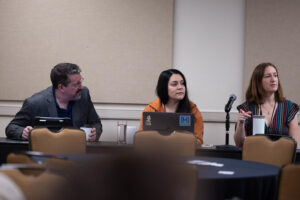News outlets have to meet the public where they are.
That was the message of leaders in news product innovation who led a breakfast workshop at the 25th annual International Symposium on Online Journalism (ISOJ) conference.
The workshop sought to introduce journalists to how news products are developed and how, ultimately, they are only as good as how they are consumed.

Panelists discuss agile newsrooms during a breakfast workshop at 25th ISOJ on April 13. (Patricia Lim/Knight Center)
“We can't pick a solution and then run with it,” Becca Aaronson, chief product officer and co-founder of News Product Alliance told the workshop attendees. “We actually have to learn from our decisions and continue to iterate upon them. This can be hard in a business that likes to rely on certainty. And you do need to have a little bit of certainty, but you also need to be able to learn from your mistakes and keep growing so that we don't fall behind.”
A news product can be a podcast, a newsletter, video series, a feature article or any content made by a news organization. For the workshop, the speakers posed a hypothetical scenario: how can the growing community of Hutto, Texas, benefit from a podcast?
That scenario was based on hypothetical data that nearly half of Hutto’s residents drove into Round Rock and Austin for work and could listen to the podcast on their commute.
Attendees immediately noted the several challenges this news-spreading method could bring to the Hutto community and the podcast creators. A small audience, with already formed habits, may not stand to benefit from a difficult production like a podcast.
“Every community has a different challenge,” Damon Kiesow, Knight Chair of Journalism Innovation at the Missouri School of Journalism said. “The processes, the way we solve problems, it's all the same conflicts. Do we have enough information? What do we know about the audience? How do we solve the internal sort of political conflict?”
Ultimately, though, the biggest struggle in deciding whether a podcast was appropriate for this hypothetical scenario is not knowing Hutto’s diverse audience and its needs. The same can be said of developing news products in general as communities around the United States grow but the amount of journalists to cover them decreases.
Factors like language, interests, political leanings, and socioeconomic status of their audience are just a fraction of what a newsroom needs to be aware of before developing a news product.
“The challenge of doing this as an imaginary exercise is none of us actually know the context of this community and this market well enough to make these decisions,” Aaronson said. “And so I think that really reinforces the point that if you're going to be making these calls in an actually informed way, you have to be really connected to the community and the market and understand the landscape.”
News product development should keep the consumer in mind, but the news outlet’s goals need to be incorporated, too, some of the journalists in the workshop mentioned. Deciding to create a news product needs to be interrogated thoroughly, with journalists needing to push back and asking why something works for them and for the public, too.
“Our goal is to solve these problems through problem solving and collaboration and sustainability,” Upasna Gautam, senior product manager leader at CNN’s Digital News Platforms team said. “And the way we do that is to not just understand the types of problems we need to solve, but why those problems are a problem in the first place. And we do that through agile product development and building an agile newsroom.”
The speakers suggested to the attending journalists that a strengths, weaknesses, opportunities and threats, or SWOT, analysis, was a good way of understanding a potential news product. The strategy will be necessary for the future, as the way news is spread will become a staple of the journalism industry.
“These are new competencies that we need to have in our programs beyond just reporting and editing, and we have people in this room who are doing that,” Cindy Royal, who is a professor in Texas State University’s Journalism and Mass Communication Department, said to the speakers. “But we need more.”
Gaige Davila is a reporter with Texas Public Radio, covering immigration, social justice, environment and culture in the Rio Grande Valley.
ISOJ is a global online journalism conference organized by the Knight Center for Journalism in the Americas at the University of Texas at Austin. In 2024, it is celebrating 25 years of bringing together journalists, media executives and scholars to discuss the impact of the digital revolution on journalism.